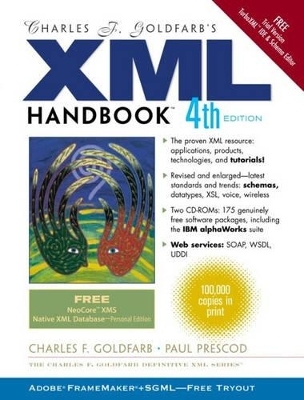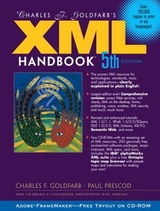
Charles F. Goldfarb's XML Handbook
Prentice Hall
978-0-13-065198-3 (ISBN)
- Titel erscheint in neuer Auflage
- Artikel merken
In the past year, there has been dramatic evolution in XML-related standards, specifications, techniques, and products. Now, Charles F. Goldfarb and Paul Prescod have updated their definitive, best-selling XML guidebook to reflect the very latest innovations. Accessible enough for non-technical managers, thorough and accurate enough for technical professionals, Charles F. Goldfarb's XML Handbook, Fourth Edition delivers practical insight for decision-making and implementation, real-world case studies, in-depth explanations of XML technologies, and more than 175 hand-picked XML software and trialware packages -- now on two CD-ROMs! Charles F. Goldfarb's XML Handbook, Fourth Edition contains extensive new coverage of the latest XML standards and specifications, including XML Web Services, XML Query, XSL, Xpath, Xlink, Xpointer, Topic Maps, and even the just-finalized XML Schema Structures and Datatypes specifications. Goldfarb and leading XML developer Paul Prescod show how XML is simplifying supply chain integration, portal and "digital dashboard" development, trading exchanges, enterprise-class Web site management, and many other applications.
They present several new enterprise case studies, and review state-of-the-art XML solutions, from Microsoft, IBM, Oracle, Sun, Intel, Hewlett-Packard, Adobe, and many others.
CHARLES F. GOLDFARB is the father of XML technology. He invented SGML, the Standard Generalized Markup Language on which both XML and HTML are based. You can find him on the Web at www.xmlbooks.com PAUL PRESCOD is a leading XML software developer, trainer, and consultant. He was a member of the W3C group that developed XML. With participation by industry leaders, including top experts from our sponsor companies.
Preface by Charles F. Goldfarb.
Foreword by Jean Paoli, co-editor of W3C XML Recommendation.
Prolog by Jon Bosak, chair of W3C XML Working Group.
I. THE WHO, WHAT, AND WHY OF XML.
1. Why XML?
2. Just enough XML.
3. The XML usage spectrum.
4. Better browsing through XML.
5. Taking care of e-business.
6. XML Jargon Demystifier(tm).
II. THREE-TIER APPLICATIONS.
7. Personalized frequent-flyer website.
8. Building an online auction website.
9. Enabling data sources for XML.
III. E-COMMERCE.
10. From EDI to IEC: The new Web commerce.
11. XML and EDI: Working together.
12. An information pipeline for petrochemicals.
IV. INTEGRATION.
13. Application integration with Web and email.
14. Integrating the mainframe.
15. Integrated provisioning.
16. Business integration.
V. CONTENT MANAGEMENT.
17. “World” class content management.
18. Content systems.
19. Components: Key to content management.
20. Components for graphic content.
VI. PORTALS.
21. Portal servers for e-business.
22. Content systems for portals.
23. RxML: Your prescription for healthcare.
24. Information and Content Exchange (ICE).
VII. PUBLISHING.
25. Personalized financial publishing.
26. High-volume data reporting.
27. Developing reusable content.
VIII. DATABASES.
28. XML and databases.
29. XPath-based XML DBMS.
30. Storing XML in a relational DBMS.
31. XML, SQL, and XPath: Getting it all together.
IX. CONTENT ACQUISITION.
32. XML mass-conversion facility.
33. Do-it-in-house mass conversion.
34. Integrating legacy data.
35. Acquiring reusable renditions.
V. SCHEMAS AND DESIGN.
36. Building a schema for a product catalog.
37. Schema management.
38. Building your e-commerce vocabulary.
39. XML design.
XI. VOICE.
40. VoiceXML in a mobile environment.
41. Adding telephony to your website.
XII. SEMANTIC WEB.
42. Extended linking.
43. Topic maps: Knowledge navigation aids.
44. RDF: Metadata description for Web resources.
45. Application integration using topic maps.
XIII. WEB SERVICES.
46. The Web services vision.
47. Web services technologies.
48. Deploying a Web service.
XIV. INFRASTRUCTURE.
49. XML processing.
50. Java technology for XML development.
51. Compression techniques for XML.
52. New directions for XML applications.
XV. XML CORE TUTORIALS.
53. XML basics.
54. Creating a document type definition.
55. Entities: Breaking up is easy to do.
56. Advanced features of XML.
57. Reading the XML specification.
XVI. SCHEMA TUTORIALS.
58. Namespaces.
59. Datatypes.
60. XML Schema (XSDL).
XVII. TRANSFORM & NAVIGATION TUTORIALS.
61. XML Path Language (XPath).
62. XSL Transformations (XSLT).
63. XSL formatting objects (XSL-FO).
64. XML Pointer Language (XPointer).
65. XML Linking Language (XLink).
XVIII. RESOURCES.
66. Free resources on the CD-ROM.
67. Repositories and vocabularies.
68. Acronyms and initialisms in The XML Handbook.
69. Other books on XML.
Index.
| Erscheint lt. Verlag | 7.1.2002 |
|---|---|
| Verlagsort | Upper Saddle River |
| Sprache | englisch |
| Maße | 178 x 235 mm |
| Gewicht | 1734 g |
| Themenwelt | Informatik ► Programmiersprachen / -werkzeuge ► XML |
| Mathematik / Informatik ► Informatik ► Web / Internet | |
| ISBN-10 | 0-13-065198-2 / 0130651982 |
| ISBN-13 | 978-0-13-065198-3 / 9780130651983 |
| Zustand | Neuware |
| Haben Sie eine Frage zum Produkt? |
